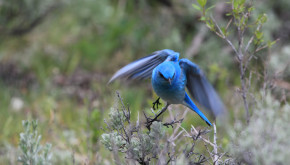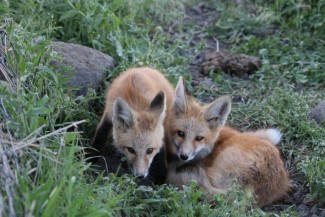
by: Nicole Strong, Oregon State University Extension, Fran Cafferata Coe, Caffereta Consulting, and Ken Bevis, Washington Department of Natural Resources
Woodland owners and managers have many reasons for owning land; enjoying wildlife and providing wildlife habitat consistently rank as one of the most important values. The following article will give you a couple ideas of how you can make sure you are creating the habitat you want.
What is Wildlife Habitat?
Wildlife habitat means differ
ent things to different species. A species’ habitat is an area with the combination of necessary resources (e.g., food, water, cover, and space) and environmental conditions (temperature, precipitation, presence or absence of predators and competitors) that allows individual species to survive and reproduce. How much habitat is enough, and what kind is right, varies greatly among wildlife species and across seasons of the year. All wildlife need habitat and wildlife use woodlands in various ways depending on the species.
It is not feasible for you to create habitat for every species of wildlife on your land. What improves habitat for one species of wildlife may degrade it for another. It is important for you to understand what your have, and how you can provide safe access to food, water, cover and travel.
Your woodland consists of trees, shrubs and plants of many age classes, states of decay, species and structure. Legacy structures, like snags, are usually woody remnants of past forests or human activities and have great value as habitat features. These can include old stumps, logs or even piles, providing habitat for many animals.
The following are key components of wildlife habitat:
Food
Wildlife look for food in many different ways. You have many tools to enhance foraging opportunities for wildlife:
· If you harvest trees off your land, leave some standing live and dead trees in the unit.
· Deciduous trees and shrubs, particularly fruit bearing species, are important food sources of insects, berries and nuts, and should be included across all forest ages and types on your land.
· Leave or create snags and down logs across all forest ages and types. The more the better, and the bigger the better. Of course, you do not want to leave dead trees near roads, your home, or places you like to walk or camp!
· Maintain stream-side and spring buffers (strips of vegetation) with a diversity of tree and shrub species.
· Consider wildlife-friendly seed mixes on your dirt roads, skid trails, and other disturbed areas. This will help wildlife and hopefully prevent those disturbed areas from becoming full of invasive species.
Safe Access to Water
Water is essential for wildlife species. They need safe access to, as well as away from water sources. There are many ways you can provide water for wildlife:
· Maintain riparian buffers on all waterways; this includes conifer and hardwood trees, shrubs, and plants.
· Enhance existing ponds so they are wildlife friendly; this includes keeping ponds well-aerated, vegetated, and free of invasive species.
· Protect known water sources such as springs with buffers. This might include actions such as preventing livestock from entering the area. Or, maybe just keeping an eye on water sources to make sure they are well vegetated.
· Consider creating water opportunities if no natural water sources are available.
Cover
Wildlife need cover to hide from predators, raise their young, to rest, and to protect themselves from harsh weather conditions. Wildlife look for cover in many different ways. The ways you can create good cover include:
· Retain existing legacy structures, such as old “wolf” trees, snags and down logs.
· Leave or create brush piles by placing large woody material (6” or greater diameter) in at least 4 layers on the bottom, covered by fine branches. Keep the branches on your logs to create spaces between them.
· Leave or create snags and down logs greater than 12 inches diameter across all forest ages and types
· Leave patches of dense shrubs in thinned forests (shrub patches 30 feet in diameter work well).
· Leave patches or grassy areas un-mowed (or wait until late summer or early Fall to mow)
Space
Wildlife require space to find food and water and in order to raise their young. Often wildlife need to move between habitat types at various stages of their life. Family forest landowners often provide the link between habitat types that allows ease of movement for wildlife. Ways to improve travel space includes:
· Minimize fencing or utilize seasonal fencing that you can lay down during known periods of time wildlife travel across your property
· Connect your forest to adjacent habitat types by planting or retaining a swath of trees and shrubs. This will create a movement corridor that is essential for many wildlife species.
How do I know if I’m making a difference for wildlife on my property?
Systematic observations and monitoring of wildlife can be a lot of fun, can help you understand your property and reach your management objectives. Monitoring is simply identifying species, ecologically important areas and habitat features and collecting baseline data to compare against future assessments. It might also include identifying potential problems (e.g., damage or invasive species). Observations of wildlife species and habitat conditions can provide indicators of habitat change over time. The Woodland Fish and Wildlife group publication Techniques and Tools for Monitoring Wildlife on Small Woodlands will help you dig deeper.
Where else can I go for more information?
There are lots of resources available to help you manage for wildlife on working forests. Here are some we recommend:
· Natural Resources Conservation Service and Soil and Water Conservation Districts
· Your local Extension office. They will have lots of publications, as well as offer workshops and tours to help you.
· Your state Department of Fish and Wildlife (or Game Commission in some states)
· Your state Forestry or Natural Resources agency
· Watershed Councils


